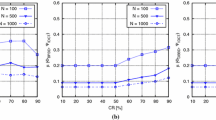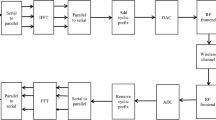Abstract
This paper aims to explore the potential benefits and performance enhancements of combining a novel error correction code with polar codes through serial and parallel concatenation. The BGCC-EDAC (Binary to Gray Code Conversion Based Error Detection and Correction) code is a novel forward error correction code that functions as a channel coding technique. It has shown promising results in effectively detecting and correcting errors. This study presents an empirical analysis of the application of serial concatenation of BGCC-EDAC-aided polar code (SC-BPC) and parallel concatenation of BGCC-EDAC-aided polar code (PC-BPC). The simulation results obtained using Cadence 90 nm technology demonstrate that the SC-BPC and PC-BPC architectures presented in this study require fewer hardware resources compared to the other error correction codes currently available. The empirical analysis conducted using MATLAB demonstrates that the proposed codes exhibit a significant performance improvement compared to CRC-aided polar codes. The PC-BPC code proposed in this study exhibits a slight enhancement of 0.18 dB compared to the parallel concatenation technique of CRC-aided polar codes at a bit error rate of 10−4. Similarly, the SC-BPC code introduced in this research displays an identical improvement of 0.3dB when compared to the serial concatenation approach with CRC-aided polar codes at the same BER level. The PC-BPC and SC-BPC architectures are expected to be widely adopted in 5G wireless communication systems due to their advantageous features such as low latency, high throughput, and improved BER performance.




















Similar content being viewed by others
Data availability
The authors declare that any data related to this research will be made available on request.
References
Liu, Y., Wang, C. X., Huang, J., Sun, J., & Zhang, W. (2019). Novel 3-D Nonstationary MmWave massive MIMO Channel models for 5G high-speed Train Wireless communications. IEEE Transactions on Vehicular Technology, 68(3), 2077–2086. https://doi.org/10.1109/TVT.2018.2866414.
Deepa, T., & Bharathiraja, N. (2021). Performance evaluation of Polar coded filtered OFDM for low latency Wireless communications. Wireless Personal Communications, 116(3), 2023–2034. https://doi.org/10.1007/s11277-020-07777-2.
Arıkan, E. (2009). Channel polarization: A method for constructing Capacity-Achieving codes for symmetric. IEEE Transactions on Information Theory, 55(7), 3051–3073.
Tal, I., & Vardy, A. (2015). List decoding of Polar codes. IEEE Transactions on Information Theory, 61(5), 2213–2226. https://doi.org/10.1109/TIT.2015.2410251.
Balatsoukas-Stimming, A., Parizi, M. B., & Burg, A. (2015). LLR-Based Successive Cancellation List Decoding of Polar codes. IEEE Transactions on Signal Processing, 63(19), 5165–5179. https://doi.org/10.1109/TSP.2015.2439211.
Niu, K., & Chen, K. (2012). CRC-aided decoding of polar codes. IEEE Communications Letters, 16(10), 1668–1671. https://doi.org/10.1109/LCOMM.2012.090312.121501.
Li, B., Shen, H., & Tse, D. (2012). An adaptive successive cancellation list decoder for polar codes with cyclic redundancy check. IEEE Communications Letters, 16(12), 2044–2047. https://doi.org/10.1109/LCOMM.2012.111612.121898.
Barg, A., & Zémor, G. (2005). Concatenated codes: Serial and parallel. IEEE Transactions on Information Theory, 51(5), 1625–1634. https://doi.org/10.1109/TIT.2005.846392.
Arikan, E. (2018). Serially Concatenated Polar codes. Ieee Access : Practical Innovations, Open Solutions, 6, 64549–64555. https://doi.org/10.1109/ACCESS.2018.2877720.
Wang, T., Qu, D., & Jiang, T. (2016). Parity-check-concatenated polar codes. IEEE Communications Letters, 20(12), 2342–2345. https://doi.org/10.1109/LCOMM.2016.2607169.
Park, J., Kim, I., & Song, H. Y. (2017). Construction of parity-check-concatenated polar codes based on minimum hamming weight codewords. Electronics Letters, 53(14), 924–926. https://doi.org/10.1049/el.2017.1037.
Eslami, A., & Pishro-Nik, H. (2013). On finite-length performance of polar codes: Stopping sets, error floor, and concatenated design. IEEE Transactions on Communications, 61(3), 919–929. https://doi.org/10.1109/TCOMM.2013.012313.110692.
Zhang, Y., Liu, A., Gong, C., Yang, G., & Yang, S. (2014). Polar-LDPC concatenated coding for the AWGN wiretap channel. IEEE Communications Letters, 18(10), 1683–1686. https://doi.org/10.1109/LCOMM.2014.2353811.
Kingston Roberts, M., Kumari, S., & Anguraj, P. (2021). Certain investigations on recent advances in the design of decoding algorithms using low-density parity-check codes and its applications. International Journal of Communication Systems, 34(8), 1–38. https://doi.org/10.1002/dac.4765.
Zhang, Y., Pan, X., Pan, K., Ye, Z., & Gong, C. (2014). A Parallel Decoding Algorithm for Short Polar Codes Based on Error Checking and Correcting. Scientific World Journal. https://doi.org/10.1155/2014/895782
Leroux, C., Raymond, A. J., Sarkis, G., & Gross, W. J. (2013). A semi-parallel successive-cancellation decoder for polar codes. IEEE Transactions on Signal Processing, 61(2), 289–299. https://doi.org/10.1109/TSP.2012.2223693.
Wu, D., Liu, A., Zhang, Y., & Zhang, Q. (2016). Parallel concatenated systematic polar codes. Electronics Letters, 52(1), 43–45. https://doi.org/10.1049/el.2015.2592.
Zhang, Q., Liu, A., Zhang, Y., & Liang, X. (2016). Practical design and decoding of parallel Concatenated structure for systematic Polar codes. IEEE Transactions on Communications, 64(2), 456–466. https://doi.org/10.1109/TCOMM.2015.2502246.
Mahdavifar, H., El-Khamy, M., Lee, J., & Kang, I. (2014). Performance limits and practical decoding of interleaved reed-solomon polar concatenated codes. IEEE Transactions on Communications, 62(5), 1406–1417. https://doi.org/10.1109/TCOMM.2014.050714.130602.
Wang, Y., Zhang, W., Liu, Y., Wang, L., & Liang, Y. (2017). An Improved Concatenation Scheme of Polar codes with Reed-Solomon codes. IEEE Communications Letters, 21(3), 468–471. https://doi.org/10.1109/LCOMM.2016.2639482.
Yu, Q., Shi, Z., Li, X., Du, J., Zhang, J., & Rabie, K. M. (2018). On the concatenations of Polar codes and Non-binary LDPC codes. Ieee Access : Practical Innovations, Open Solutions, 6(c), 65088–65097. https://doi.org/10.1109/ACCESS.2018.2877178.
Wang, X., Li, J., Chang, H., & He, J. (2020). Optimization design of polar-LDPC concatenated scheme based on deep learning. Computers and Electrical Engineering, 84, 106636. https://doi.org/10.1016/j.compeleceng.2020.106636.
Vaz, A. C., Nayak, C. G., Nayak, D., & Hegde, N. T. (2022). Decoding of Turbo Code and Polar Code using deep learning for visible light communication. Journal of Engineering Science and Technology, 17(4), 2776–2787.
Krasser, F. G., Liberatori, M. C., Coppolillo, L., Arnone, L., & Castiñeira Moreira, J. (2021). Fast and efficient FPGA implementation of Polar codes and SoC test bench. Microprocessors and Microsystems, 84(May), 104264. https://doi.org/10.1016/j.micpro.2021.104264.
Li, J., Reviriego, P., Xiao, L., Argyrides, C., & Li, J. (2018). Extending 3-bit burst error-correction codes with quadruple adjacent error correction. IEEE Transactions on Very Large Scale Integration (VLSI) Systems, 26(2), 221–229. https://doi.org/10.1109/TVLSI.2017.2766361.
Li, J., Xiao, L., Reviriego, P., & Zhang, R. (2018). Efficient implementations of 4-Bit burst error correction for Memories. IEEE Transactions on Circuits and Systems II: Express Briefs, 65(12), 2037–2041. https://doi.org/10.1109/TCSII.2018.2817390.
Liu, X., Wu, S., Wang, Y., Zhang, N., Jiao, J., & Zhang, Q. (2020). Exploiting error-Correction-CRC for Polar SCL Decoding: A deep learning-based Approach. IEEE Transactions on Cognitive Communications and Networking, 6(2), 817–828. https://doi.org/10.1109/TCCN.2019.2946358.
Ning, S. (2018). Advanced bit flip concatenates BCH code demonstrates 0.93% correctable BER and faster decoding on (36 864, 32 768) emerging memories. IEEE Transactions on Circuits and Systems I: Regular Papers, 65(12), 4404–4412. https://doi.org/10.1109/TCSI.2018.2840350.
Shirmohammadi, Z., & Mahdavi, Z. (2018). An efficient and low power one-lambda crosstalk avoidance code design for network on chips. Microprocessors and Microsystems, 63(May 2017), 36–45. https://doi.org/10.1016/j.micpro.2018.08.002.
Maheswari, M., & Seetharaman, G. (2013). Multi bit random and burst error correction code with crosstalk avoidance for reliable on chip interconnection links. Microprocessors and Microsystems, 37(4–5), 420–429. https://doi.org/10.1016/j.micpro.2013.03.001.
Qin, Z., Fei, Z., Huang, J., & Xiao, M. (2022). Secure Online Fountain codes with Low Complexity. IEEE Communications Letters, 26(7), 1499–1503. https://doi.org/10.1109/LCOMM.2022.3167716.
Maheswari, M., & Seetharaman, G. (2013). Hamming product code based multiple bit error correction coding scheme using keyboard scan based decoding for on chip interconnects links. Applied Mechanics and Materials, 241–244, 2457–2461. https://doi.org/10.4028/www.scientific.net/AMM.241-244.2457.
Dutta, A., & Touba, N. A. (2007). Multiple bit upset tolerant memory using a selective cycle avoidance based SEC-DED-DAEC code. Proceedings of the IEEE VLSI Test Symposium, 349–354. https://doi.org/10.1109/VTS.2007.40.
Reviriego, P., Martínez, J., Pontarelli, S., & Maestro, J. A. (2014). A method to design SEC-DED-DAEC codes with optimized decoding. IEEE Transactions on Device and Materials Reliability, 14(3), 884–889. https://doi.org/10.1109/TDMR.2014.2332364.
Li, J., Reviriego, P., Xiao, L., Liu, Z., Li, L., & Ullah, A. (2019). Low delay single error correction and double adjacent error correction (SEC-DAEC)codes. Microelectronics Reliability, 97(February), 31–37. https://doi.org/10.1016/j.microrel.2019.03.012.
Reviriego, P., Argyrides, C., & Maestro, A., J (2012). Efficient error detection in double error correction BCH codes for memory applications. Microelectronics Reliability, 52(7), 1528–1530. https://doi.org/10.1016/j.microrel.2012.01.017.
Lin, C. H., Chen, C. Y., Wu, A. Y., & Tsai, T. H. (2009). Low-power memory-reduced traceback MAP decoding for double-binary convolutional turbo decoder. IEEE Transactions on Circuits and Systems I: Regular Papers, 56(5), 1005–1016. https://doi.org/10.1109/TCSI.2009.2017118.
Dizdar, O., & Arikan, E. (2016). A high-throughput energy-efficient implementation of Successive Cancellation Decoder for Polar codes using Combinational Logic. IEEE Transactions on Circuits and Systems I: Regular Papers, 63(3), 436–447. https://doi.org/10.1109/TCSI.2016.2525020.
Yen, S. W., Hung, S. Y., Chen, C. L., Chang, H. C., Jou, S. J., & Lee, C. Y. (2012). A 5.79-Gb/s energy-efficient multirate LDPC Codec chip for IEEE 802.15.3c applications. IEEE Journal of Solid-State Circuits, 47(9), 2246–2257. https://doi.org/10.1109/JSSC.2012.2194176.
Balatsoukas-Stimming, A., Raymond, A. J., Gross, W. J., & Burg, A. (2014). Hardware architecture for list successive cancellation decoding of polar codes. IEEE Transactions on Circuits and Systems II: Express Briefs, 61(8), 609–613. https://doi.org/10.1109/TCSII.2014.2327336.
Xia, C., Chen, J., Fan, Y., Tsui, C. Y., Jin, J., Shen, H., & Li, B. (2018). A high-Throughput Architecture of List Successive Cancellation Polar codes Decoder with large list size. IEEE Transactions on Signal Processing, 66(14), 3859–3874. https://doi.org/10.1109/TSP.2018.2838554.
Chang, T. C. Y., & Su, Y. T. (2015). Dynamic weighted bit-flipping Decoding algorithms for LDPC codes. IEEE Transactions on Communications, 63(11), 3950–3963. https://doi.org/10.1109/TCOMM.2015.2469780.
Hajiyat, Z. R. M., Sali, A., Mokhtar, M., & Hashim, F. (2019). Channel Coding Scheme for 5G Mobile Communication System for short length message transmission. Wireless Personal Communications, 106(2), 377–400. https://doi.org/10.1007/s11277-019-06167-7.
Voicila, A., Declercq, D., Verdier, F., Fossorier, M., & Urard, P. (2010). Low-complexity decoding for non-binary LDPC codes in high order fields. IEEE Transactions on Communications, 58(5), 1365–1375. https://doi.org/10.1109/TCOMM.2010.05.070096.
Funding
The authors did not receive support from any organization for the submitted work. No funding was received to assist with the preparation of this manuscript. No funding was received for conducting this study. No funds, grants, or other support were received.
Author information
Authors and Affiliations
Contributions
All Authors are responsible for the correctness of the statements provided in the manuscript.
Corresponding author
Ethics declarations
Conflict of interest
The Authors confirm that there are no known conflicts of interest associated with this publication and there has been no significant financial support for this work that could have influenced its outcome.
Ethical approval
Animal research: The Authors declare that this research does not contain any studies with animal subjects. Plant reproducibility: The authors declare that this research does not contain any studies with plants.
Consent to participate
The authors declare that this research does not contain any studies with humans or individual participants.
Consent for publication
The authors declare that this research does not contain any studies with individuals or patients and hence no data is associated to be published.
Additional information
Publisher’s Note
Springer Nature remains neutral with regard to jurisdictional claims in published maps and institutional affiliations.
Rights and permissions
Springer Nature or its licensor (e.g. a society or other partner) holds exclusive rights to this article under a publishing agreement with the author(s) or other rightsholder(s); author self-archiving of the accepted manuscript version of this article is solely governed by the terms of such publishing agreement and applicable law.
About this article
Cite this article
Radha, N., Maheswari, M. An empirical analysis of concatenated polar codes for 5G wireless communication. Telecommun Syst 85, 165–188 (2024). https://doi.org/10.1007/s11235-023-01078-2
Accepted:
Published:
Issue Date:
DOI: https://doi.org/10.1007/s11235-023-01078-2




